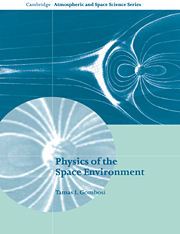Book contents
Chapter 13 - Cosmic Rays and Energetic Particles
Published online by Cambridge University Press: 22 October 2009
Summary
Understanding the fundamental properties of the energetic particle population in the heliosphere is very important for two reasons:
These particles represent considerable hazard for both humans and radiation-sensitive systems in space, because they can penetrate through large amounts of shielding material.
They carry information about the large-scale properties of the heliosphere and the galaxy.
High-energy cosmic ray particles carry a large amount of kinetic energy. The deposition of this energy can cause permanent effects in the material through which the cosmic ray particle passes. In the case of biological materials or miniature electronic circuits, these effects can be very serious. In order to provide adequate shielding for radiation-sensitive systems, we need to know the basic properties of the high-energy particle radiation, including its elemental composition, energy spectrum, and temporal variations.
A significant portion of our present knowledge about the global structure of the heliosphere comes from energetic particle observations. These particles travel through space at velocities considerably higher than the characteristic velocities of the local plasma population. Because the propagation of the energetic particles is greatly affected by various physical properties of the medium, energetic particles sample regions of the heliosphere and the galaxy that are currently not accessible to spacecraft.
- Type
- Chapter
- Information
- Physics of the Space Environment , pp. 257 - 277Publisher: Cambridge University PressPrint publication year: 1998



